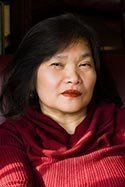How an Anthology of Filipino Canadian Writing Was Born
/This was in 2008 and already Filipino American writers were on their third anthology, a tradition began back in 2002. Field of Mirrors came out as third in a series of anthologies: Reflections: Readings for Young and Old (2002) and Whisper of the Bamboo (2004), published by Philippine American Writers, Inc.
Thus, when Ted Alcuitas, editor of the online Philippine Canadian News, emailed me on November 12, 2019, the year before the Covid 19 pandemic, about co-editing an anthology of Filipino Canadian writing, I had some idea of where we were going.
Ted, who was actively involved with the Asian Canadian Writers (ACW) group in Vancouver, said he had been inspired by ACW founder Jim Wong Chu’s suggestion on the need to highlight our kababayan writers’ works in a collection. Ted then broached the idea to playwright Chris Gatchalian who was then teaching in British Columbia.
Toronto editors C.E. Gatchalian and Patria Rivera. (Photo by Ricardo Caluen)
Our common enthusiasm coalesced. I told them it was about time we focused on our emerging and established writers and help them claim their space in Canadian literature. There is so much breadth, depth, and creativity that Filipino Canadians could contribute though the written word.
Our vision was to produce a list of writings that celebrates our literary works and provides inspiration for future generations of writers. Our contributors. Who were they, and where were they?
We received close to a hundred submissions, and from these, we selected the pieces we believed would best represent the variety of experiences of Filipino Canadians.
We started with what we knew and whom we knew. We knew that our numbers were growing. But at the time, we worked with estimates. Two years later, we had them. Figures from the 2021 census by Statistics Canada report close to a million or 957,355 Canadians with Filipino roots and that the Philippines was the third largest source country for immigration to Canada—with 757,410 people reporting as Philippine-born immigrants to Canada—following India (1.2 million) and China (830,980).
Just over three-quarters (76.5%) of Filipino Canadians were living in Ontario (355,680 people), Alberta (203,960) and British Columbia (172,915) at the time of the census. As well, Canadians with Filipino roots could be found in every province and territory of Canada.
Where were they? Think vast: Canada, with its land area of 9,976,182 square kilometers, is the second largest country in the world. The internet provided the links and closed many of the communication gaps.
We began with whom we knew, read, or read about, or referred to by literary friends -- a core group of established writers we invited to contribute. Later, we expanded the coverage to include emerging writers who had never been published.
It took us two years to get this going, right through the pandemic, gathering material from writers across Canada through calls for submissions on social media and local news outlets. We received close to a hundred submissions, and from these, we selected the pieces we believed would best represent the variety of experiences of Filipino Canadians.
We drew up the themes, edited the pieces, and prepared them for submission to Cormorant Books which, through earlier negotiations with Chris, had accepted the anthology for publication.
There have been some missteps and hiccups along the way, but we finally sorted them out to present an anthology that celebrates and honors our experiences, joys, and struggles as a people and a community.
Magdaragat is Filipino for “seafarer” or “mariner,” we noted in our introduction. We come from an archipelago of some 7,000 islands in the South Pacific, and “the sea, as both literal and metaphorical entity, has dominated Filipino life — economically, politically, and culturally — since time immemorial.”
Book Cover: Magdaragat: An Anthology of Filipino-Canadian Writing, published by Cormorant Books, 2024.
Today, more than 1.83 million of the Philippines’ 110 million citizens are overseas Filipino workers (OFWS). In terms of “overseas Filipinos,” meaning people of Filipino ancestry regardless of citizenship, the number jumps to about 12 million compatriots.
Thus, from the Introduction: “The phenomena of Filipinos forced out of their homelands because of political corruption and poverty, and of Filipino women leaving their own children behind to care for others’ children abroad, are well documented.
“What isn’t as well documented is the extreme disconnection felt by many second-generation diasporic Filipinos — the children of Filipino immigrants — from the culture of their ancestral homeland…
“The inner lives of Filipinos — especially those who have just immigrated to Canada and are working service jobs to make ends meet — remain a mystery to most white Canadians. For example, most have little to no idea of the high levels of education Filipinos typically achieved prior to arriving in this country; many were practicing doctors, lawyers, or architects in the Philippines. It’s a life of personal agency and fulfillment — not one dedicated to caring for others in wealthy foreign countries — that most Filipinos hope and train for.”
With Magdaragat, the Anthology, some understanding of those inner lives would be available to those who seek stories behind the faces of these sojourners who sought a new life in uncharted shores.
The crowd at the Toronto launch. (Photo by Ricardo Caluen)
March 20 Toronto launch: The Toronto writers with editors C.E. Gatchalian and Patria Rivera. (Photo by Ricardo Caluen)
Patria Rivera is co-editor of Magdaragat: An Anthology of Filipino-Canadian Writing, published by Cormorant Books and recently launched in Toronto, Ontario, in March this year.
More articles from Patty Rivera







